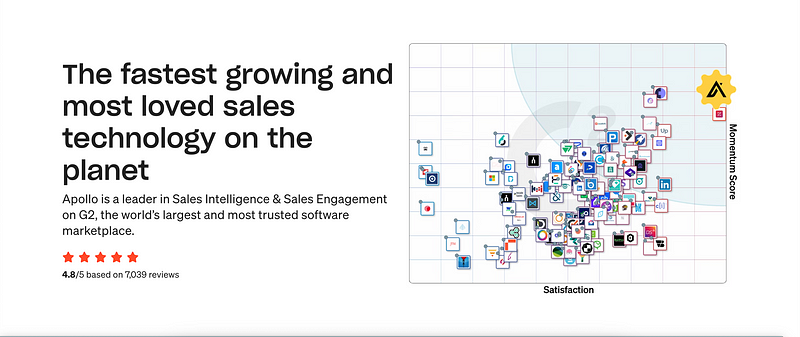How Apollo’s Niche Features Help Web Designers Find Clients Efficiently
Apollo is a powerful sales and marketing platform widely known for its ability to help businesses streamline their lead generation and…

Apollo is a powerful sales and marketing platform widely known for its ability to help businesses streamline their lead generation and sales processes. While it serves a broad range of industries, Apollo has several niche features that make it particularly effective for website designers looking to find clients. Here are some of the standout features that can help web designers connect with potential clients and grow their business:
1. Advanced Prospecting and Search Filters
Apollo offers advanced prospecting capabilities that allow website designers to find companies or individuals who might need web design services. The platform’s search filters enable users to narrow down leads based on specific criteria, such as company size, industry, location, and technology stack. For web designers, this is a game-changer. By filtering prospects based on whether a company is using outdated web technologies or lacks a responsive website, designers can identify businesses that are more likely to need a redesign or a new website altogether.
2. Technology Stack Filtering
One of Apollo’s unique features is its ability to filter prospects by the technology stack they are using. This means web designers can focus on companies that are using specific content management systems (CMS), programming languages, or e-commerce platforms. For example, a designer who specializes in Shopify or WordPress can easily find companies that use these platforms and may need design or customization services. This level of targeting ensures that designers are reaching out to leads that are more likely to be interested in their expertise.
3. Intent Data for Lead Scoring
Apollo’s integration with intent data providers gives web designers an edge by allowing them to prioritize leads based on buying signals. Intent data indicates when a company is actively looking for web design services, browsing relevant content, or engaging with competitors. This feature allows web designers to approach leads at the right time — when they are most likely to need design services. It also saves time by focusing efforts on high-quality prospects rather than cold leads.
4. Automated Outreach and Follow-up
A common challenge for web designers is maintaining consistent communication with leads, especially when balancing client work and business development. Apollo’s automation tools simplify this process. Designers can set up personalized email sequences to send follow-up messages automatically if a lead doesn’t respond. The platform also includes templates that can be customized for specific prospects, making it easier to maintain a professional and tailored outreach strategy without spending hours on manual tasks.
5. CRM Integration for Streamlined Client Management
Apollo integrates seamlessly with most major CRM systems, allowing web designers to manage their client interactions more effectively. With CRM integration, designers can track conversations, set reminders for follow-ups, and maintain a clear overview of where each lead is in the sales pipeline. This feature helps designers stay organized and ensure no lead falls through the cracks, which is crucial for turning prospects into paying clients.
6. Contact Enrichment and Accurate Data
For web designers, reaching the right decision-makers is critical. Apollo’s contact enrichment feature ensures that users have access to up-to-date information about potential clients, including job titles, email addresses, and social media profiles. This makes it easier for designers to connect with key stakeholders, such as marketing managers, business owners, or IT directors, who are more likely to have a say in web design decisions.
7. Collaboration and Team Features
For web design agencies or teams, Apollo’s collaboration features are particularly useful. Multiple team members can collaborate on lead generation, assign tasks, and share notes about prospects. This is especially helpful for agencies that have both sales and design teams working together to close deals. The ability to coordinate efforts in one platform improves communication and helps ensure that everyone is aligned on client outreach strategies.
8. Client Segmentation and Targeting
Apollo’s ability to segment leads based on different criteria is invaluable for web designers. Whether a designer is focusing on small businesses, startups, or large enterprises, they can create different segments within the platform and tailor their messaging accordingly. For example, a designer might create a segment for small local businesses that need basic websites, and another segment for larger companies that might require custom designs or complex web development. This targeted approach helps increase the chances of converting leads into clients.
9. Lead Recommendations Based on Historical Data
Apollo’s machine learning algorithms analyze user activity and lead data to recommend new prospects based on historical success. For website designers, this means the platform can suggest new leads that are similar to past clients who have shown interest in their services. By leveraging this feature, designers can continuously find new opportunities without needing to manually search for leads all the time.
10. Integration with Social Media Platforms
For many website designers, LinkedIn and other social media platforms are essential tools for networking and client acquisition. Apollo’s integration with LinkedIn allows users to easily find and connect with potential clients. Designers can use Apollo’s LinkedIn extension to gather information about prospects, view shared connections, and send personalized connection requests, all from within the platform. This integration streamlines the process of building relationships and expanding professional networks.
Conclusion
Apollo’s powerful suite of features makes it an ideal tool for website designers looking to find new clients. Its advanced search filters, technology stack targeting, intent data, and automation tools allow designers to efficiently identify and engage with high-quality leads. Additionally, its CRM integration and team collaboration features ensure that designers can manage their sales process effectively and turn prospects into paying clients. By leveraging Apollo’s unique capabilities, web designers can streamline their business development efforts and focus on what they do best — creating stunning websites for their clients.
These niche features make Apollo not only a robust sales tool but also an invaluable asset for any web designer looking to grow their client base in a competitive market.





